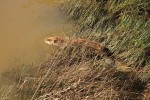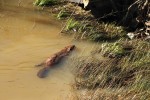
SEATTLE – Sometimes moving to a new neighborhood is the best choice for everyone. That’s the theory behind a research project by the Tulalip Tribes of Washington to relocate beaver families. The critters have become a nuisance in the lowlands but in higher elevations, their hard work can benefit the entire Snohomish watershed.
Ben Dittbrenner is a graduate student of University of Washington Environmental and Forestry Sciences and he’s working with the Tribes to trap and move beavers and study the effects of their dam-building. When less snow is predicted with a changing climate, he says a beaver dam is just the right type of eco-friendly barrier to moderate spring runoff.
“It will just flow right down to Puget Sound and it won’t stay in the system for more than a couple days,” says Dittbrenner. “But if we can trap it high up in the watershed, we can keep it there for months and hopefully continue to keep those systems healthier for a longer period of time.”
Great work Washington! (Well moving beavers is better than killing them, but not as good as learning how to coexist. Let’s be clear.) But Ben is working hard on what I think is his dissertation so we’re happy he’s adding to the data pool. I first met Ben at the State of the beaver conference 2013. I was dashing to lunch with Mike Callahan in between our presentations, and a young man we didn’t know asked if he could tag along. Ben was working at that time for the Snohomish public works, and was one of two folk assigned to fill Jake Jacobsen’s shoes when he retired. Ben and Mike got talking about fish passage in flow devices and eventually he became the site where the new adaptions were tried. Now he’s hard at work at the School of Environmental Forestry at the University of Washington. The last I heard his dissertation was about using beavers to mitigate climate change, which is a very valuable topic. Great work Ben!
Onto Washington, where one syndicated columnist finds humor in the cherry blossom drama. Tom Purcell is actually writing about beavers in 1999, which. considering they returned in 2007 is a good lesson about the futility of either trapping or relocation. The story is a bit of a bus-man’s holiday for us here in Martinez – but it’s a fun article anyway. Enjoy!
The National Cherry Blossom Festival is beginning. The cherry trees, 3,700 of them given to America by the Japanese in 1912, will soon be in full bloom. It reminds me why Americans are so wary of Washington.
In the spring of 1999, you see, some culprits had been chopping down cherry trees. The National Park Service, in a state of high alert for days, finally identified the tree fellers: three beavers, who decided to construct a dam in the Tidal Basin.
In a normal city, this situation would have been dealt with swiftly. The beavers would have been trapped, transported to another location and released. In fact, People for the Ethical Treatment of Animals (PETA), not known for common sense solutions, suggested exactly that.
But Washington is no normal city.
No sooner was PETA’s idea floated than experts began crawling out of the woodwork. One said it would be tragic to separate the three beavers, since they’re likely from the same family.
Another said you can’t move beavers to a new colony because the new colony — beavers are Republicans? — would reject the freeloaders. Besides, what’s the point of being a beaver if you don’t have any buddies to plug up storm sewers with?
A third expert said that, all things considered, the most humane solution would be to euthanize the beavers. Boy, did the public react negatively to that suggestion.
This is because beavers are cute. Their cuddly television presence clouded the public’s ability to address the problem rationally.
The fact is that if beavers looked more like their pointy-nosed cousins, rats, even PETA would have lined the banks of the Tidal Basin with rifles and shotguns to take out the varmints before they felled more beloved trees.
Ha! Write this down: when people see beavers they are harder to kill. We know it’s true. Certainly true here in Martinez. I hope it’s true everywhere. Of course he points fingers at PETA but there’s no need to single anyone out. Everyone can care about beavers if given the chance. I guess NPS learned part of their lesson from the public response and used their visibility to make a tree mascot for the blessed blossoms. Lemons and lemonade. Hmm, someone is smart.

Now for the completion of long term goals here at beaver central. I always loved the idea of using this in some kind of printing, but it was too weird for a shirt and too detailed for a poster. I loved how the bandana came out on my recent button order from zazzle, so I’m adding historical touch. Doesn’t this make you want to be a beaver researcher in a dusty stone library somewhere?

























































